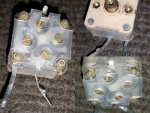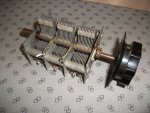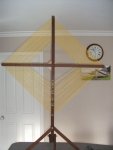All the references I have read online, including FAQ on this site, talks about using lengths of wire and a good quality variable capacitor. I have finally obtained a plastic capacitor from my friend who mentioned it was pulled from AM/FM/SW radio. My question is whether this would work and how to go about soldering the contacts. It has four points. Plus, it is missing a knob. Is there a way to check it using a multi-meter? My goal is to make an antenna similar to Tecsun or Terk inductive loop antenna. Below is the collage of images.
That's a polyvaricon capacitor. There are actually two sections to it; since it came out of a broadcast band radio it's possible that both sections are approximately 0-365 pF (picofarads) which is a common value for a BCB radio; it could also be 0-20pF + 0-365pF and so on. What you really need is the 0-365pF section, although the 0-20pF section would limit your tuning range if you really wanted to do that, but you would need to make sure the inductance of the loop is
really close to what you actually need.
You can use a multimeter to determine capacitance if it has a capacitance meter function built in; otherwise you would need a capacitance meter add-on for your multimeter, or an actual capacitance meter.
There are ideas for knobs here:
Also check Mike's Electronic Parts, all kinds of neat stuff:
Mike's Electronic Parts – Hard to find electronic parts
Another question: Can I simple get a fixed value capacitor, let's say, for 640 kHz single frequency reception? I'm sure there's a calculation that will tell how much pF capacitor I'd need. Thanks in advance.
You could do this, but I'd recommend going with the variable capacitor. Various things can cause the inductance of the loop antenna to vary including the size of the wire, the number of turns, the spacing of the turns and the diameter of the loop, even what's adjacent to the loop, so you would be much better off using the variable capacitor so you can tweak it as needed.
A lot of the fun of this is fiddling about with stuff to see what happens. Best bet is to build the loop following the instructions, and hook up one side of the capacitor to the feed loop; if it works you're all set and if not, try the other side of the capacitor. You could also try putting the sections of the capacitor in parallel or series to see how that affects things.






